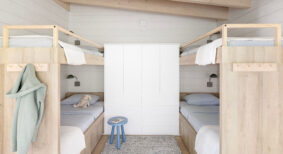“All that glitters” is no longer the gold standard in design. As we continue to see modern interiors influenced by Scandinavian-style, a noticeable shift away from polished surfaces and fixtures has dominated design trends. Designers and clients alike are embracing the texture, warmth, and functionality of matte finishes.
FLOORING
The movement toward matte is perhaps most apparent in flooring choices. Low-sheen hardwood dominates the marketplace, and manufacturers have responded to the maintenance and durability issues of oiled flooring with new technology in polyurethane finishes. A raw, natural aesthetic is now achievable with a maintenance-free finish, offering long-term protection against stains and scratches.
Similarly, tile and stone flooring are experiencing a resurgence. The aesthetic qualities of honed natural stone, whether in large format or geometric mosaics, haves becoming a trademark feature in modern luxury interiors. Where matte natural stone may fall short in terms of durability, affordability and sustainability, porcelain tile has responded. Vast improvements in realistic-looking stone patterns, paired with maintenance-free matte finishes have elevated the desirability of porcelain flooring.
SURFACES
From everyday functional surfaces to specialty installations, the use and availability of matte finishes continue to grow. Polished finishes have long been the predominant option in countertops, however honed and matte finishes are growing in popularity and availability. Honed granite and concrete are no longer the sole option for matte durability. Quartz manufacturers have responded to the matte trend by introducing low-sheen slabs in desirably modern tones such as white, grey and simulated marble.
Vertical surfaces can be enhanced by a growing range of matte materials. The raw, industrial aesthetic of ship-lap concrete can be recreated via board-form concrete tile, making for a much more feasible fireplace facing or accent wall. For bathrooms and kitchens, matte wall tiles have gone beyond basic rectangular porcelain formats and now feature interesting geometric patterns or three-dimensional surfaces. Such tiles may be precision crafted or feature a more hand-made quality with ridges, ribbing, or sculpted geometric patterns, adding texture and depth to otherwise sleek and minimal spaces.
FIXTURES
Often regarded as the “jewelry” of interior design, lighting, plumbing fixtures and hardware have become a more understated feature in modern spaces. While years past saw a trend in brushed-gold fixtures and hardware, it’s fair to say black is the current metal finish of choice. Once designated for rustic or traditional spaces, matte black plumbing fixtures are now available in sleek, modern silhouettes, making them suitable for the modern interiors. Alternately, for a more minimal and airy aesthetic, matte white plumbing fixtures are a growing trend, offering tonal simplicity and pure functionality in a sleek modern form.
Light fixtures are typically synonymous with glitz and sparkle. Designers of modern spaces have often struggled with the balance of adding decorative light fixtures for interest and function, without detracting from an otherwise clean and minimal interior. The shift to matte finishes is seen in parallel with a move towards extremely minimal light fixture design.
Perhaps thanks to the new abundance in suitable LED options, modern “decorative” fixtures have become anything but. Simple elongated tubes or bars in matte white or black become solitary, airy statements above kitchen islands or workspaces. Cylindrical ceiling-mount can lights (again, matte white or black) become stylish alternates for recessed fixtures. And even in the realm of overtly decorative fixtures such as chandeliers and wall sconces, the focus is on simple geometric forms and subtle, matte finishes.
FURNISHINGS
As modern interiors embrace quieter palettes, the elements of form, texture, and tonal contrast play a fundamental role in furniture and textile selections. Case goods, tables and accent pieces are offered in a multitude of matte finishes. Matte wood finishes range from raw and natural, to cerused finishes with pigmented grain or rich, dark charcoal and ebony stains. Metal accents such as furniture legs, bases and frames formerly provided that “hint of bling” in polished chrome. These elements are now more architectural, often in matte black, white or even a subtle accent colour in a powder-coated finish.
Thoughtful selection of upholstery and textiles adds warmth and texture to modern interiors, without detracting from the architecture.
- Natural fibres are an ideal solution; their pure and unblended form is innately matte.
- Wool and cotton-velvet are an excellent choice for upholstery, providing consistent texture and colouring which highlights the clean forms of modern furniture beautifully.
- The woven texture of linen adds depth and interest paired against clean forms and smoother surfaces and works well for both upholstery and window coverings.
- Modern area rugs also depict a shift to more natural, matte finishes.
- Wool rugs being the most popular and versatile, ranging from chunky woven textures to smooth cut-pile, provide warmth, durability and an environmentally friendly, sustainable choice.
Stephanie Brown, BAID, RID, is principal interior designer of Stephanie Brown Inc., a residential design firm in Vancouver.







